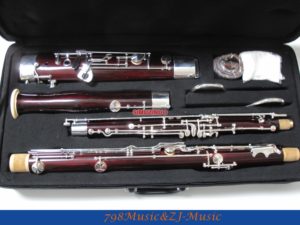The Enchanting Melodies of the Bassoon:
Unveiling the Hidden Beauty of this Unique Woodwind Instrument

Step into the world of enchanting melodies and uncover the hidden beauty of a truly unique woodwind instrument – the bassoon. Often overlooked, this captivating instrument possesses a charm that is sure to captivate both musicians and listeners alike. From its distinct deep and rich tone to its intricate craftsmanship, the bassoon has the power to transport you to a realm of musical wonder.
In this exploration, we will dive deep into the history, technique, and repertoire of this unsung hero of the orchestra. Discover the artistry of the skilled bassoonist as they effortlessly navigate the complexities of this double-reed instrument, creating melodies that resonate with elegance and mystique.
Join us on this journey as we unveil the secrets and allure of the bassoon, shedding light on its often-overlooked role in the symphony of sounds. Prepare to be enchanted, as we delve into the world of the bassoon and uncover the hidden beauty that lies within.
History and Origin of the Bassoon
The bassoon has a fascinating history that dates back several centuries. Its origins can be traced back to the Renaissance period, where it evolved from earlier double-reed instruments such as the shawm and the dulcian. The modern bassoon, as we know it today, took shape during the Baroque period, with the addition of key mechanisms and improvements in its overall design.
During the 18th and 19th centuries, the bassoon became an integral part of the symphony orchestra, lending its unique voice to the compositions of Mozart, Beethoven, and other great composers of the time. Its popularity continued to grow, and by the 20th century, the bassoon had firmly established itself as a staple in both orchestras and chamber ensembles.
Anatomy of the Bassoon

To truly appreciate the beauty of the bassoon, it is essential to understand its intricate anatomy. The bassoon consists of several parts, each playing a crucial role in producing its distinct sound. Starting from the top, the instrument features a double reed mouthpiece, followed by a long conical body, which is divided into four main sections – the wing joint, boot joint, long joint, and bell.
The bassoon’s body is typically made from maple or another type of hardwood, allowing for optimal sound resonance. The key mechanism, located on the body of the instrument, enables the player to control the pitch and produce the desired musical phrases. The bassoon’s unique shape and design contribute to its characteristic deep and resonant sound.
Unique Characteristics of the Bassoon’s Sound
The bassoon’s sound is often described as rich, warm, and velvety. Its deep and mellow tone adds a distinctive layer to the overall sound of an ensemble or orchestra. The instrument’s range spans over three octaves, from the lowest B♭ to the highest F♯.
The bassoon’s versatility allows it to play a wide variety of musical styles, from lyrical and expressive melodies to lively and playful passages. Its ability to blend seamlessly with other instruments makes it an invaluable asset in ensemble performances. The bassoon’s unique timbre and expressive capabilities have earned it a special place in the hearts of many composers and musicians.
Famous Bassoonists Throughout History
Over the centuries, many talented bassoonists have left their mark on the world of music. One such notable figure is Italian composer and bassoonist Antonio Vivaldi. His virtuosic bassoon concertos, such as “La notte” and “La tempesta di mare,” are still widely performed and admired today.
Another renowned bassoonist is French musician and composer François-René Gebauer. He was not only a skilled performer but also a prolific composer, leaving behind a significant body of work for the bassoon. His compositions showcase the instrument’s expressive capabilities and technical agility.
In the modern era, bassoonists like Klaus Thunemann and Milan Turkovic have continued to push the boundaries of the instrument, captivating audiences with their exceptional artistry and innovative interpretations. Their contributions have helped elevate the status of the bassoon and showcase its immense musical potential.
The Role of the Bassoon in Orchestras and Ensembles
The bassoon plays a crucial role in the symphony orchestra, providing a solid foundation in the lower register and acting as a bridge between the woodwind and brass sections. Its deep and resonant sound adds depth and richness to the overall ensemble sound, enhancing the harmonic framework of the music.
In chamber ensembles, the bassoon often takes on a more prominent melodic role, showcasing its expressive capabilities and ability to create captivating melodies. Its unique timbre allows it to blend seamlessly with other instruments, creating a harmonious and balanced ensemble sound.
Popular Pieces Featuring the Bassoon
Numerous classical compositions feature the bassoon in prominent roles. One such example is Mozart’s Bassoon Concerto in B-flat major, which is considered a cornerstone of the bassoon repertoire. This concerto showcases the instrument’s virtuosity, melodic capabilities, and ability to captivate listeners with its expressive qualities.
Other notable pieces featuring the bassoon include Stravinsky’s “The Rite of Spring,” where the instrument adds a haunting and mysterious element to the overall orchestral texture, and Prokofiev’s “Peter and the Wolf,” where the bassoon represents the character of the grumpy grandfather.
Tips for Learning to Play the Bassoon
Learning to play the bassoon can be a rewarding and fulfilling journey. However, it requires dedication, patience, and proper guidance. Here are a few tips to help aspiring bassoonists on their musical path:
- Find a qualified bassoon teacher who can guide you through the fundamentals of playing the instrument, including proper technique, breath control, and embouchure formation.
- Practice regularly and consistently to build strength and endurance. Start with shorter practice sessions and gradually increase the duration as you progress.
- Listen to recordings of professional bassoonists to develop an understanding of the instrument’s unique sound and musical style.
- Join a local orchestra or ensemble to gain practical experience and perform alongside other musicians.
- Experiment with different reeds to find the one that suits your playing style and produces the desired sound.
Maintaining and Caring for Your Bassoon

Proper maintenance and care are essential to ensure the longevity and optimal performance of your bassoon. Here are a few guidelines to help you keep your instrument in top condition:
- Clean your bassoon regularly using a soft cloth and a cleaning rod. This helps remove moisture and debris that can accumulate inside the instrument.
- Oil the key mechanism periodically to ensure smooth and effortless key action.
- Store your bassoon in a secure and stable environment, away from extreme temperatures and humidity.
- Have your bassoon serviced by a professional technician at least once a year to address any minor repairs or adjustments.
Conclusion: Rediscovering the Beauty of the Bassoon
The bassoon, often overshadowed by its more popular counterparts, possesses a hidden beauty that is waiting to be discovered. Its enchanting melodies and unique timbre have the power to evoke a range of emotions, from deep introspection to joyous celebration. As we journeyed through the history, technique, and repertoire of this unsung hero of the orchestra, we were able to uncover the secrets and allure of the bassoon.
From its humble beginnings to its prominent role in orchestras and ensembles, the bassoon has left an indelible mark on the world of music. Its distinct sound and expressive capabilities continue to captivate audiences and inspire musicians of all ages. So, next time you listen to a symphony or chamber ensemble, take a moment to appreciate the enchanting melodies of the bassoon and the hidden beauty that lies within.
